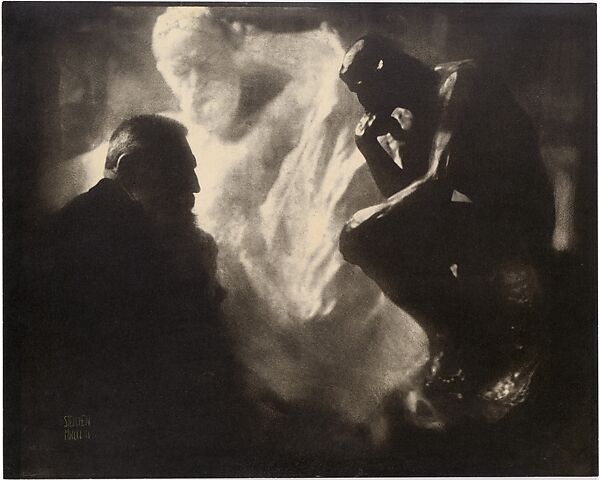In the early 19th century, photography was perceived as a means of reproducing reality, but photographers like Steiken began to pursue artistry by utilizing painterly techniques. Steiken’s ‘ Rodin with Victor Hugo and a Thinking Man ‘ is a representative example of a pictorialist photograph that emphasizes artistic expression through composite photography techniques and contrast. These attempts were instrumental in establishing photography as an art form.
Until the early 19th century, photography was perceived as a technological tool of modern civilization and a means of reproducing reality. People at the time considered photography to be an objective record of reality. Gradually, however, many photographers attempted to express their own subjectivity by taking or creating staged photographs. They pursued artistic photography by imitating painterly expression through techniques such as light processing and compositing of original plates. The photographic works created in this trend are called pictorialist photography. Painterly photography was an attempt to capture artistic expression beyond mere documentation, opening up the possibility of photography being recognized as art on the same level as painting.

Steiken’s ‘ Rodin with Victor Hugo and a Thinking Man (1902)’ is considered to be a representative of Pictorialist photography. In this work, the subjects are the sculptor Rodin and his works ‘ Victor Hugo and The Thinking Man. Steiken took a photograph of Rodin in front of the marble statue ‘ Victor Hugo ‘ and a photograph of the bronze statue ‘ The Thinking Man ‘ and composited them into a single photographic work. In the composition of the photograph, Rodin and The Thinker sit in a similar position facing each other in the darkened near view, while Victor Hugo looks down on them in the lightened far view. Rather than simply compositing the near and far views, the artist employed a difficult composite photographic technique that allowed the subjects of the two photographs to be positioned in the same frame, as the artist intended. In addition, the photographic process used a light-sensitive solution that suppressed the texture of the subjects.
From 1901 onward, Steiken had an artistic exchange with Rodin, photographing his works almost weekly. Rodin’s sculptures emphasized vitality and expressiveness, a departure from the art world’s tendency at the time to reproduce only the outward appearance of objects, which Steiken appreciated and deeply identified with. Steiken believed that a photograph or sculpture could express the subjectivity and emotions of the artist and could be subject to interpretation, just like a literary work, and Rodin agreed, willingly serving as a model for his photographic works.
In this photograph, I tried to make the subjects look like human beings by processing the textures of the subjects to make them look lifeless. While the great literary figure of Victor Hugo is looking down, Rodin is in the same pose of contemplation, facing the ”Thinker,” as if he has become the ”Thinker” himself. Victor Hugo, white and bright in the distance, appears to radiate the inspiration of creation in contrast to the darker figures of Rodin and the Thinker in the near distance. This composition conveys the message that Rodin’s work, like his literature, was created in the anguish of creation.
Steiken’s work had a profound impact on the art world of his time and was instrumental in establishing photography as an art form. He showed that photography could be used as a medium of creative expression, not just a tool for documentation. By shooting for sharp contrasts, compositing plates to create compositions, and altering textures with special light sensitizers, Steichen sought to show that photography could be created and expressed in the same way as painting. These attempts inspired many subsequent photographers and made an important contribution to the development of the art of photography.
Thanks to the efforts of artists like Steinbeck, today we can appreciate photography as a work of art, more than just a document. As such, pictorialist photography is considered an important art historical movement that expanded the possibilities of photography and opened up new areas of art. While they are outstanding works of art in their own right, they are also significant as monumental achievements that played an important role in the historical development of photographic art.
